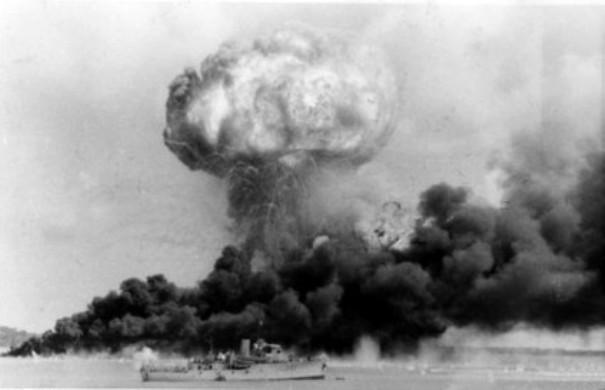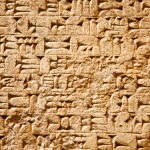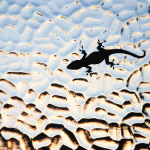
Explosion of an oil storage tank during the first Japanese air raid on Darwin. Image: WikimediaCommons/Australian War Memorial, RAN Historical Collection
Seventy years ago the droning of aircraft could be heard above Darwin.
Many people initially assumed that they were American aircraft or that it was an RAAF training exercise, but the 54 land-based bombers and 188 attack aircraft had, in fact, been launched from four Japanese aircraft carriers in the Timor Sea and headed towards Darwin. They were led by Captain Mitsuo Fuchida, who had executed a similar attack on Pearl Harbour (December 7, 1941).
At 9.58 am the first bomb landed on Stokes Hill Wharf, just seconds after the air raid siren first sounded. World War II had reached Australian shores.
The first attack lasted 40 minutes, the bombers targeting the harbour, the town and both the civil and military aerodromes. An hour later, Royal Australian Air Force base at Parap was bombed in a second attack that lasted 25 minutes.
Fearing an invasion, half of Darwin’s civilian population and many RAAF servicemen began to head south towards the Adelaide River and the train. This exodus was later referred to as ‘the Adelaide River stakes’. Three days after the attack, 278 servicemen were still missing.
The attacks left 243 Allied service personnel and civilians dead, and between 300 and 400 wounded; 20 military aircraft and eight ships were destroyed, along with much of Darwin’s civil and military facilities. However, the Australian Government said only 17 people had died — Singapore had fallen to the Japanese a few days earlier and the government was concerned about damaging morale.
http://www.youtube.com/watch?v=pMLPjNlrTZs&feature=player_embedded
The next 18 months saw more air raids over Australia; Broome was strafed on March 3, 1942; and Darwin was attacked 64 times, with the final raid taking place on November 12, 1943. Many other towns were bombarded, including Wyndham, Port Hedland and Derby in Western Australia; Darwin and Katherine in the Northern Territory; Townsville and Mossman in Queensland, and Horn Island in the Torres Strait.
According to the Australian War Memorial, there were a total of 97 air attacks, and aircraft reconnaissance continued over northern Australia for much of 1944.
Despite the perceived threat of invasion, the Japanese were planning to invade Timor at the time. However, the air raids interrupted the use of Darwin’s port facilities and tied up air force units and anti-aircraft defences. The outbreak of war had led to the enlargement of the military presence in Darwin, which was considered a vital part of Australia’s defences. It was used to deploy forces for the defence of the Dutch East Indies.
The bombing of Darwin remains the largest foreign attack on Australia. There is still evidence of these attacks today — a bomb crater was discovered in Darwin’s city centre by a road-works crew in October 2010.
Sources: The Australian War Memorial and the National Archives of Australia






